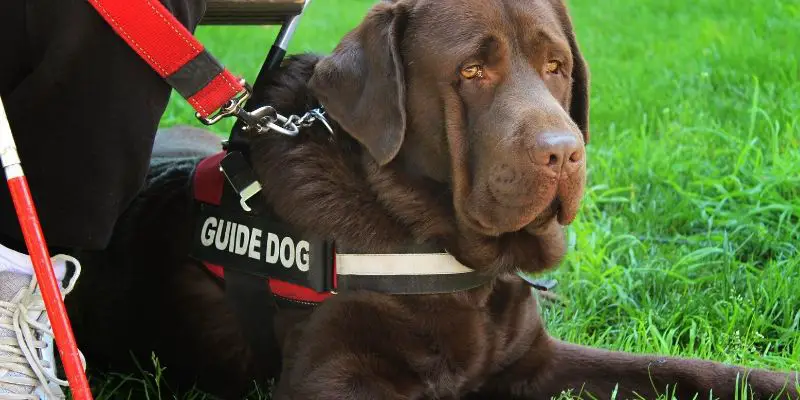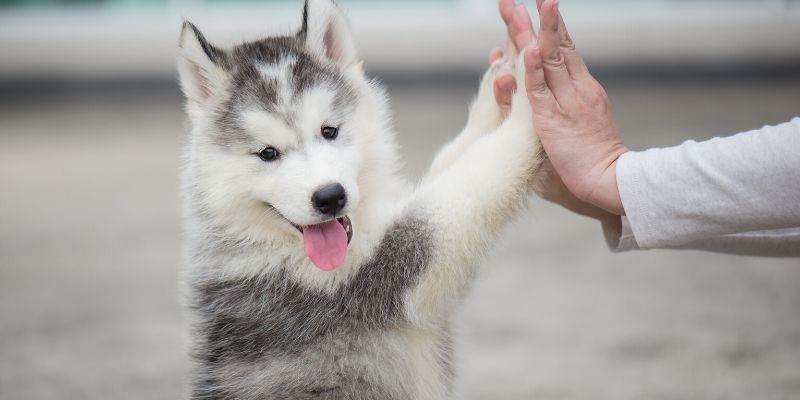Individuals with disabilities can improve their lives with the help of a service dog (not the same as an emotional support dog!). The Americans with Disabilities Act or ADA allows people with disabilities to use a trained service dog for daily tasks and activities. But to get that kind of dog is not as easy as it has to be. So I tried to cover the most basic questions that you might have before going through that challenge.
Do you have a specific question on the subject? Then use the table of contents below to jump to the most relevant section. And you can always go back by clicking on the black arrow in the right bottom corner of the page. Also, please note that some of the links in this article may be affiliate links. For more details, check the Disclosure section at the bottom of the page.
- What are service dogs for?
- Reasons to have a service dog
- Can anyone have a service dog?
- Who qualifies for a service dog?
- What disabilities qualify for a service dog?
- Application for service dogs
- How to get approved for a service dog?
- Requirements for a service dog?
- Where to apply for a service dog?
- How to get approved for a service dog?
- Can your application be rejected?
- Will medicare pay for a service dog?
- How long does it take to get a service dog?
What are service dogs for?

Service dogs are for people who have specific types of disabilities. E.g., those who are vision or hearing impaired or dealing with issues such as autism or PTSD. These dogs live with their owners/handlers perform tasks their owners are unable to do themselves.

Reasons to have a service dog
There are several reasons why one should have a service dog, including:
- Physical benefits. Specific disabilities, such as epilepsy or limited mobility, can be managed with the help of a service dog. Dogs can help with many daily tasks, such as paying cashiers or pressing handicapped accessible buttons. But at the same time, a service dog can turn out to be lifesaving for those suffering from epilepsy. Such dogs are known as seizure alert pets, which prevent injuries during a seizure.
- Emotional benefits. It offers a great sense of companionship and connection, but at the same time allows an individual to use its independence. A service dog can assist you with day to day tasks without the need to request help from other people.
- Social life improvements. A service dog can improve a disabled person’s social experience. With such a pet, they can go to more places than they would be able to go without the assistance of their service dog.

Can anyone have a service dog?

Some people wonder if anyone can have a service dog or if just people with disabilities can own such a dog. The answer to that question is both yes and no. While anyone can own a trained service dog, not anyone can use it. If you do not have a disability for which the service dog is taught to assist you, then your dog is considered just a pet regardless of their training.

Who qualifies for a service dog?

Here are some of the requirements that are needed to qualify for a service dog:
- Be at least 12 years of age, unless the service dog is required for a child with autism, and be capable of caring for and commanding your dog.
- Have a diagnosis from a medical professional that stands proof for the disability, anxiety disorder (such as PTSD), debilitating chronic illness, or neurological disorder that affects at least one limb.
- Live in a stable home.
- Have the ability to manage a service dog independently.
- Have the financial, emotional, and physical means to take care of a service dog.
- Have no other dog in his home.
- You are also required to have a letter (called a prescription letter) from the doctor that has treated your medical condition for the last 6 months. This letter has to state that a service dog could be helpful to you and also giving specific tasks that the dog will need to be able to perform. (And you should check out American Service Pets, they are one of the best suppliers for quality service pet letters which will increase your chances of getting the approval).
Besides, children with autism can qualify for a service dog if:
- They are between 6 and 12 years of age.
- Have on other dogs in their home.
- They are participating in a current educational program.
- They are participating in a therapy program.
- Have a parent, sibling, or guardian over 18 who lives with them, so that they manage the dog’s needs accordingly.

What disabilities qualify for a service dog?

As mentioned on the Service Dog Registry’s website, several disabilities can make an individual eligible for a service dog. These include:
- Mobility Issues (Including Paralysis)
- Sensory Issues (Blindness, Hearing Loss, etc.)
- Diabetes
- Multiple Sclerosis (MS)
- Cancer
- Autism
- Epilepsy
- Bone and Skeletal (Such as Osteoporosis, Scoliosis, etc.)
- Post-Traumatic Stress Disorder

Application for service dogs
The application process for receiving a service dog is straightforward, and you can send your application online.
The documents needed for requesting a service dog might include:
- A pre-qualifying questionnaire in which you explain your situation and how a service dog can help you.
- A note that was written by your doctor or mental health professional in which is recommended for you to use a service dog for emotional support and not only. Keep in mind that this letter mustn’t be older than 12 months.
- Proof of a diagnosis from a medical professional for the disability.
- Proof that you have the financial, emotional, and physical means to take care of a service dog.
- Proof that you live in a stable home that allows you to bring in a service dog.

How to get approved for a service dog?

You should know that receiving approval for getting a service dog depends mostly on the type of program you enroll in. As such, you can benefit from support programs for individuals with physical or mental disabilities. But at the same time, there are numerous programs of assistance for veterans with physical or mental disabilities.
One of the most requested types of service dogs is the one for people who have blindness or other visual impairments. These dogs are meant to offer an improved sense of independence while keeping you safe. Also, dogs in this category are specially trained, so that they overcome any needs you might have.
So, to get approved for a service dog isn’t difficult, but it requires you to submit additional information about your health status and living conditions. The goal is to help you benefit from a dog’s service. But at the same time, the dog has to be cared for too.
Therefore, if you want to become eligible for a service dog as fast as possible, it is highly recommended to prepare your portfolio accordingly. The primary certification you need to have is the one that explains your disability and why your medical practitioner recommends a service dog.
From this point on, qualifying for a service dog is rather simple. The association from which you will receive your furry companion will assess your home, living conditions, and your day to day requirements. Then they will be able to identify the best service dog for your situation.

Requirements for a service dog?

Not just any dog can be a service dog. There are several requirements that a service dog (or it’s the owner) must meet.
Here are the 5 most important of them:
- You have to identify and understand the type of dog that will be trained. While any dog can be trained to be a service dog, you do need a specific breed (or breeds). Knowing that will give you insight into possible future health or behavior problems. You also need to have the dog checked to make sure it is healthy, and it should undergo a personality test.
- You have to find a trainer you trust or train the dog yourself. You can find a company that actually specializes in training service dogs and allow them to choose and train a dog for you based on your needs. You can also choose a dog yourself and have it prepared by a professional, or you teach the pet yourself. Training the dog yourself can form a closer bond, but it does help to have the advice and direction of someone skilled at training service dogs.
- The dog has to be trained. In the United States, there are no minimum requirements for training a service dog. Still, international standards suggest that you teach a service dog for 120 hours over 6 months. 30 of those hours should be spent teaching the dog in public so he can avoid distractions and deal with unexpected situations.
- The dog should pass the public access test. That will ensure that this dog can be in public without posing a safety risk to its owner or other people or animals it may encounter. The dog should show no signs of aggressive behavior in any situation. It should exhibit no sniffing behavior unless it is relevant to do so. It should not beg for food or attention from other people and should not get excited or become overactive.
- You have to take care of certifying and equipping your service dog. The government of the US does require that a service dog have any special certification to prove it is a service dog. However, many public employees require such proof. So it is always a good thing to be able to show a document that your dog has been trained as a service dog. And you should carry a service dog ID and vest with you to avoid being turned away from some public places.

Where to apply for a service dog?

There are several places that provide and train service dogs for those people who need one. Sites such as Paws with a cause, Semper K9, or ICAN are just some of the training and facilities that can be applied to get a trained service dog or have your own dog trained. Most of these places offer the actual application form online for you to fill out.

How to get approved for a service dog?
If you and your physician both feel that a service dog is right for you then you will need to get approved in order to get a trained service dog.
Here is what you will need to get approval from most places:
- Must have a disability that qualifies you for getting a service dog. Some impairments that can receive service dogs include those who are seeing or hearing impaired. People with PTSD, or Autism, People with diabetes, Epilepsy, MS or some other chronic disorder. People who have lost the use of one or more limbs. There are other conditions that may qualify as well.
- You must meet the age requirements and be able to participate in training.
- You must fill out the application correctly and have a prescription letter from your doctor stating how a service dog can help you and what tasks the dog needs to be able to perform.
- Must be able to prove you can provide the dog with a stable home and can financially afford to feed and care for it and provide adequate vet care.

Can your application be rejected?
The fact that you and your doctor feel that will benefit from having a service dog does not automatically qualify you to receive one. Your application can be rejected for many different reasons.
After interviewing you, the people reviewing your application may decide that you simply do have the means or the temperament to successfully bond with and command a service dog. You also may fail to meet one or more of the requirements for a service dog, making you ineligible for such a pet.

Will medicare pay for a service dog?
Medicare won’t pay for you to obtain a service dog, go through the training, feeding your service dog, or providing them with pet care. However, if you do receive disability payments, you can use those payments to help you with the expenses of obtaining and caring for a service dog.
However, keep in mind that some places will provide you with a service dog for free, and often your community will help you raise the necessary funds. You need to explore all the means of getting financial aid in obtaining your service dog and getting the training you need.

How long does it take to get a service dog?

Even after your application for a service dog has been accepted, it can take quite some time to actually get your service dog. For starters, the service may not have a dog available that can perform the specific tasks that you need.
Should that be the case, it could take several months to train a dog that can perform those tasks. If you have a dog that you want to be trained as a service dog, then again, the process can take months, even if everything goes smoothly.
Should you want to train your dog yourself then training may take as long as two years.
Even given the best-case scenario, you should plan on waiting at least 6 months and often a year or more for your service dog depending on the need and the demand for one of these dogs.
Thanks for the blog graphics: Canva.com


